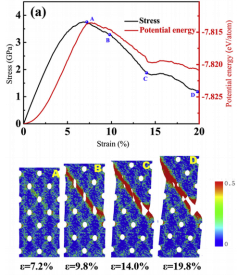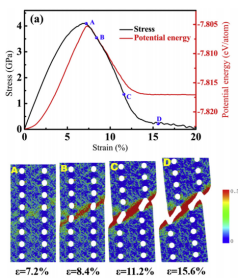

Porous metallic glass (MG) structures are good candidates for structural and functional applications due to their light weight, enhanced ductility and specific surface area. Motivated by the improvement of mechanical properties of MGs, we perform molecular dynamics simulations on uniaxial tensile strain of monatomic Ta MG with nanoscale porous structures, focusing on the effects of pore stacking, size, as well as the strain rate on deformation behaviors. Obvious atomic level fracture from necking to shear sliding or accompanied with a network of multiple SBs are observed, and relating deformation transition from brittle to ductile is declared. It is found that: (i) AB pore stacking results in an improved ductility contrary to AA pore stacking with weakened ductility, and pore stacking inclining at 45° with respect to the loading direction may not necessarily deteriorate the ductility; (ii) Ultimate tensile stress decreases with the pore diameter, due to increasing porosity; and (iii) Better ductility is shown under higher strain rate for nanoporous MG structures due to the formation of the network of multiple SBs. This study is expected to shed light on the modulation of mechanical properties by designing the pore stacking and size in metallic glasses.
文章链接:Journal of Non-Crystalline Solids.2019, 506:6-13. (SCI一区)